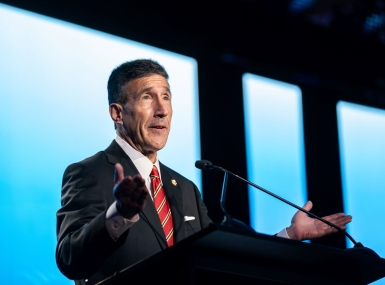How counties can use the new elective pay mechanism to finance clean energy projects
Author

Paige Mellerio
Upcoming Events
Related News

Key Takeaways
OVERVIEW
On June 14, the U.S. Department of the Treasury (Treasury) and the Internal Revenue Service (IRS) issued proposed regulations on elective pay (otherwise known as direct pay), a new tax credit delivery mechanism established in the Inflation Reduction Act (IRA). Elective pay provides tax-exempt entities, including county governments, with the ability to monetize certain clean energy tax credits that they have previously been unable to access given their lack of tax liability. Now, if a county places a project into service that meets all the requirements of an eligible clean energy tax credit, they can receive a refund equal to the full amount of the credit by filing a tax form with the IRS.
Counties interested in pursuing clean energy projects can rely on the proposed regulations until final regulations are published in the Federal Register. Comments on the proposed regulations must be submitted to the IRS by August 14, 2023.
HOW CAN COUNTIES MAKE AN ELECTIVE PAY ELECTION?
Counties will need to take the following steps in order to successfully make an elective pay election and receive a refund equal to the amount of the credit they are seeking to claim:
Identify the project and the corresponding credit
Counties will need to ensure that their project qualifies for one of the 12 clean energy tax credits for which an elective pay is applicable (more information on these credits is available here). Counties will also have to provide all the necessary documentation to demonstrate to the IRS that their project meets all the requirements of the applicable credit.
Place the project into service and determine the corresponding tax year
Counties must place their project into service prior to making an elective pay election. Once the project is placed into service, counties must determine the corresponding tax year. For most projects, the tax year will correspond with the calendar year, meaning that if the project is placed into service in 2023 the corresponding tax year will also be 2023.
Determine when the tax return is due
For most counties, tax returns are due four and a half months after the end of their tax year. For example, a county whose tax year is the calendar year and places a project into service in 2023 would need to file a return by May 15, 2024. Counties may also be able to receive a six month extension.
Complete pre-filing registration with the IRS prior to the tax return due date
Counties will need to complete a pre-filing registration process with the IRS prior to making an elective pay election. After completing the process, counties will receive a registration number that corresponds to a single project in a single tax year. if the county plans to claim a credit on the same project in future years, they will need to receive a new registration number for each year.
Counties will need to submit information related to the project and the credit they intend to claim, in addition to other details. More information on the pre-filing registration process is expected later this year.
File a return by the due date
Once a county receives a registration number from the IRS, they can make an elective pay election on their tax return. Counties, who generally do not have tax liability and do not formally file returns, will use Form 990-T. They will also be required to submit supporting documentation on the project as well as any required form associated with the credit they intend to claim.
The return must be filed by the due date, or any extension date. Further, an elective pay election can only be made on an original return, not an amended return, and late returns will not be accepted.
Receive a direct payment from the IRS
If the return is filed successful – meaning that the pre-filing registration was completed, the project meets all the requirements of the credit being claimed, and the return was filed in a timely manner – then the county will receive a payment directly from the IRS, either electronically or through the mail.
Notably, the IRS is not required to provide a direct payment until the due date of the return, so even if a county files a return early, they are not guaranteed a payment before the due date.
ARE INSTRUMENTALITIES ELIGIBLE TO MAKE AN ELECTIVE PAY ELECTION?
Yes.
Agencies and instrumentalities of county governments are eligible to make an elective pay election. examples of these entities include hospitals, school districts and economic development corporations.
IS ELECTIVE PAY A FEDERAL GRANT OR LOAN PROGRAM?
No.
Unlike a federal grant program, in which a county may be competing against other entities for funding, counties are guaranteed a direct payment equal to the amount of the credit if they successfully complete all the steps outlined above.
CAN ELECTIVE PAY BE COMBINED WITH FEDERAL GRANTS AND LOANS?
Yes.
Counties can combine tax-free grants and forgivable loans with elective pay to finance a clean energy project. this means that if a county is funding a project using a grant or a loan and successfully makes an elective pay election, they will still receive the full credit amount as a direct payment from IRS, as long as the direct payment amount combined with the tax-free grant and/or loan does not exceed the total project cost.
WHAT TYPES OF OWNERSHIP STRUCTURES ARE ELIGIBLE TO MAKE AN ELECTIVE PAY ELECTION?
A county must generally own the project for which they are claiming the applicable credit. However, that ownership can take on forms. For example, a county could own the project directly through a tenancy in directly or indirectly through a disregarded entity or through a partnership that has properly elected out of Subchapter K of the Internal Revenue Code.
Related News

House Natural Resources Committee Considers the Endangered Species Act Amendments Act of 2025
On March 6, House Natural Resources Committee Chairman Bruce Westerman (R-AR) introduced the Endangered Species Act Amendments Act of 2025 (H.R. 1897), which makes several important changes to the Endangered Species Act (ESA) and addresses key county concerns.

County Countdown – April 21, 2025
Every other week, NACo's County Countdown reviews top federal policy advocacy items with an eye towards counties and the intergovernmental partnership. This week features the ARPA reporting deadline, a budget reconciliation update and more

White House signs executive orders to boost coal industry
On April 8, President Trump signed four [RY1] [CM2] executive orders (EOs) focused on the U.S. coal industry, aligning with the Administration’s “Unleashing American Energy” EO signed in January 2025.


